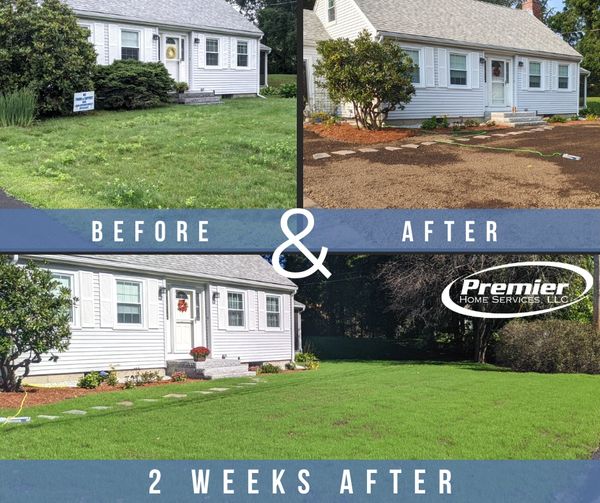how to care for a newly seeded lawn

you invested in your lawn. give it the CARE & attention it deserves.
Growing and maintaining a healthy lawn requires effort. Newly seeded lawns require time and attention, particularly in the beginning when "baby grass" appears and roots develop.

We will set you up for success
Premier will do the hard work of making a new lawn, but you will take it from there. Read the info below to help your new lawn grow and flourish.
" MY LAWN WAS JUST SEEDED. NOW WHAT?"
1. water it!

Moisture triggers the grass seed germination process and the seedlings' (“baby grass”) shallow roots require constant moisture. If the grass seed dries out between waterings, it likely will die. We recommend watering twice per day for 15-20 minutes depending on the weather conditions and watering restrictions. New lawn needs less water, but the ground should stay moist.
Established lawns that have just been patch- or overseeded require more water because the grass roots drink it up!
But don’t OVER water it… Over watering causes the seeds to rot. It also leads to soil erosion and potential diseases.
If it’s going to rain at least .25” in 24 hours, you do not need to water. When the baby grass grows gets to 2” in height, you can reduce the frequency of watering, but should not stop watering altogether.
Our recommendation?
Set up a sprinkler with a timer so it runs at the same time and for the same amount of time each day. Or, consider installing an irrigation system. We recommend Flannery Irrigation in Stow (flanneryirrigation@verizon.net)
2. BABY IT

Don’t walk on it! The baby grass needs space to germinate and grow. Limit foot traffic and activity on the lawn during the first growing season.
Give it a baby lawn blanket. You may want to cover the turn with a quality, weed-free covering. This will help:
· Reduces moisture loss.
· Keep the birds from eating too much of the seed!
· Prevent runoff
We recommend using burlap as a covering, especially on slopes, with landscape staples to hold it in place. It’s inexpensive, easy to install and readily available at the local hardware store. It’s a natural material that can be left on the ground while the grass grows. DO NOT PULL UP THE BURLAP WHEN YOU SEE NEW GROWTH! It will tear out the baby grass roots.
You can also use straw or an agricultural fabric as a covering, if you prefer.
"what happens after the grass starts to grow?"
"WHEN DO I MOW IT?"
FEED IT - WHEN IT'S READY
FEED IT - WHEN IT'S READY

Once your baby grass has grown to 3-4" inches tall, it should be mowed. The first mowing should even out the height by cutting off only one-half inch to three-quarters inch. Cutting too much will shock the grass and it may die.
FEED IT - WHEN IT'S READY
FEED IT - WHEN IT'S READY
FEED IT - WHEN IT'S READY

You should wait at least 6 weeks before applying fertilizer. When the seedlings reach two inches, a light fertilization of one-half pound of nitrogen per 1,000 square feet can be beneficial.
If the lawn is seeded in the fall, proper fertilization helps the grass mature to the point where it can survive cold weather stresses.
If you're not sure about what kind of fertilizer to use or how to fertilize, we strongly recommend contacting a fertilizer company.
We recommend Fresh Lawn Care. Feel free to tell them Premier sent you!
"why does it look patchy?"
"why does it look patchy?"
"why does it look patchy?"

Be patient with your new lawn. It can take a full season for the lawn to fill in. The root mat needs to be properly cared for so that it can continue to flourish.
You may be tempted to put down more grass seed. We advise against putting more seed down while the lawn is germinating.
Seed should be raked in for proper germination. Raking the new lawn too soon will damage existing baby grass root mat. Also, too much grass seed causes undue competition for resources such as light, water and nutrients, and grass seedlings struggle as a result.
We recommend aeration and overseed every fall for maximum lawn health. Contact us today to schedule your annual aeration and overseed service!
long-term lawn care
"why does it look patchy?"
"why does it look patchy?"

To maintain your investment, proper lawn care should continue each season. This includes:
Regular mowing no shorter than 3.5"
Regular watering: 1" of water per week is the minimum recommend amount
Fertilizer treatments
Dethatch in the spring
Aeration and overseed in the fall
Remove leaves and debris from the lawn in the fall
Premier Home Services, LLC
Cookie Notice
Cookies are used to analyze website traffic and optimize your website experience. By accepting our use of cookies, your data will be aggregated with all other user data. We may never look at it. We're not even sure how.